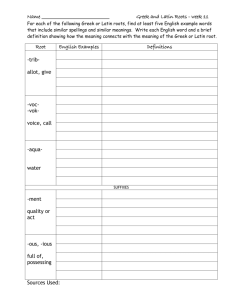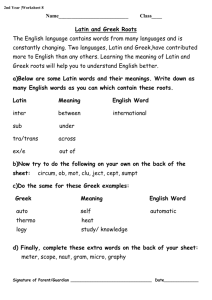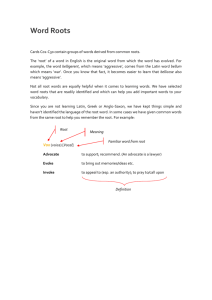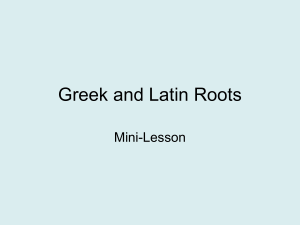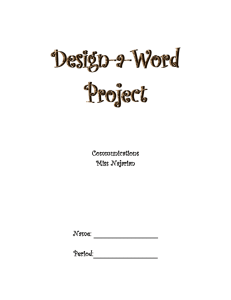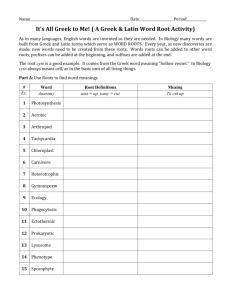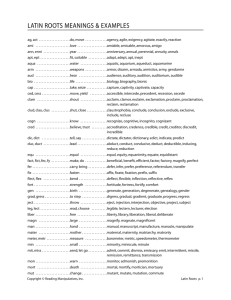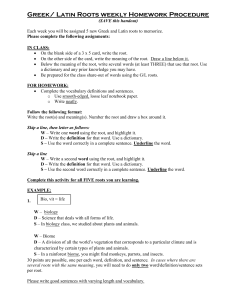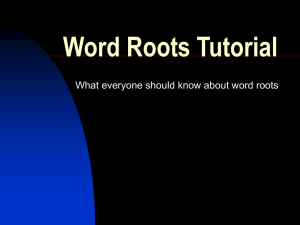Greek/Latin Root Quiz - Graduate School of Education
advertisement
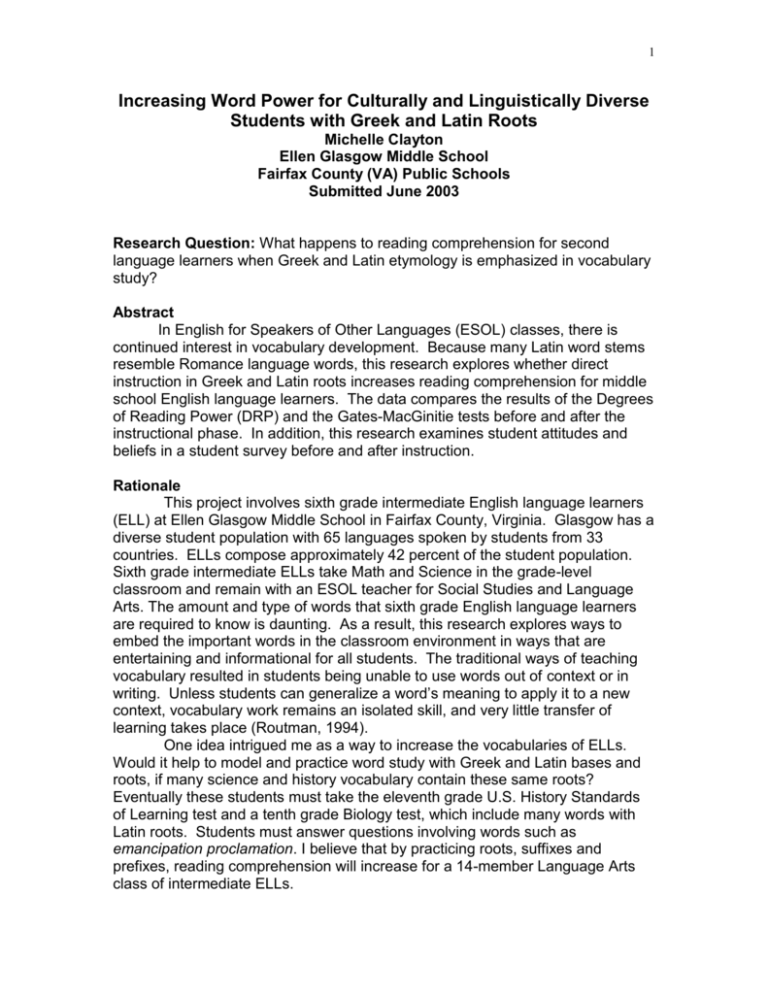
1 Increasing Word Power for Culturally and Linguistically Diverse Students with Greek and Latin Roots Michelle Clayton Ellen Glasgow Middle School Fairfax County (VA) Public Schools Submitted June 2003 Research Question: What happens to reading comprehension for second language learners when Greek and Latin etymology is emphasized in vocabulary study? Abstract In English for Speakers of Other Languages (ESOL) classes, there is continued interest in vocabulary development. Because many Latin word stems resemble Romance language words, this research explores whether direct instruction in Greek and Latin roots increases reading comprehension for middle school English language learners. The data compares the results of the Degrees of Reading Power (DRP) and the Gates-MacGinitie tests before and after the instructional phase. In addition, this research examines student attitudes and beliefs in a student survey before and after instruction. Rationale This project involves sixth grade intermediate English language learners (ELL) at Ellen Glasgow Middle School in Fairfax County, Virginia. Glasgow has a diverse student population with 65 languages spoken by students from 33 countries. ELLs compose approximately 42 percent of the student population. Sixth grade intermediate ELLs take Math and Science in the grade-level classroom and remain with an ESOL teacher for Social Studies and Language Arts. The amount and type of words that sixth grade English language learners are required to know is daunting. As a result, this research explores ways to embed the important words in the classroom environment in ways that are entertaining and informational for all students. The traditional ways of teaching vocabulary resulted in students being unable to use words out of context or in writing. Unless students can generalize a word’s meaning to apply it to a new context, vocabulary work remains an isolated skill, and very little transfer of learning takes place (Routman, 1994). One idea intrigued me as a way to increase the vocabularies of ELLs. Would it help to model and practice word study with Greek and Latin bases and roots, if many science and history vocabulary contain these same roots? Eventually these students must take the eleventh grade U.S. History Standards of Learning test and a tenth grade Biology test, which include many words with Latin roots. Students must answer questions involving words such as emancipation proclamation. I believe that by practicing roots, suffixes and prefixes, reading comprehension will increase for a 14-member Language Arts class of intermediate ELLs. 2 Literature Review Students learn clusters of words instead of one word when they analyze, sort and search for related words rather than memorize definitions (Hennings, 2000). To help students learn word clusters, teachers should guide students to highlight Greek and Latin roots as they occur and use Greek and Latin roots to connect new words with already familiar words. In addition, teachers should facilitate recognizing prefixes within content area studies, analyzing prefixes with numerical and negative connotations; and evaluating suffixes. Students who have grown up in homes with adults who have not completed high school or college may not have been exposed to the specialized vocabulary derived from Greek and Latin roots. As a result, these children are at a disadvantage in content area studies (Hennings, 2000). Studying Greek and Latin roots can improve verbal standardized test scores as well as increase vocabulary. In a study titled “A Computerized Method to Teach Latin and Greek Root Words: Effect on Verbal SAT Scores,” two groups of students took a pretest and posttest of the SAT (Scholastic Aptitude Test). One group subsequently underwent six weeks of practice on a computer program designed to drill Greek and Latin roots and the decoding of English words. The first goal of the study was to recognize root words, and then apply those roots to learning English derivatives. Holmes and Keffer compiled a list of the 150 most frequently used nouns, verbs, and adjectives in Latin and Greek from a variety of reference works. The research indicates that the teaching of Latin had a uniformly positive effect on English verbal skills (Holmes, 1995). The research also demonstrated that a knowledge of Latin and Greek root words improved the English skills of students through a broad range of grade levels (Holmes, 1995). Does increased decoding lend itself to greater reading comprehension as well? When teachers instruct English prefixes, suffixes and roots, they provide students with an additional decoding strategy. The research indicates that learning Latin roots, prefixes and suffixes enhances decoding, spelling and vocabulary (Adams, 1997). Latin roots such as form, port, rupt, spect, struct, tract, scrib/script, dic/dict, and vers/vert are very useful for students studying for the PSAT (Pre Scholastic Aptitude Test) and SAT (Adams, 1997). Methods This project is divided into three phases: pre-testing, instruction and posttesting. The first phase involved administering a survey to my students to measure their knowledge and attitudes toward Greek and Latin roots (Appendix A). The survey asked students whether they knew how to identify roots within words and about their approach to new vocabulary. In addition, it questioned them on their confidence level and enjoyment of learning vocabulary. The second piece of pre-testing included dividing my Language Arts classes into two different sections—Class B would receive instruction in Greek and Latin roots and Class A would receive no instruction in roots. In the posttesting phase both groups were to take the Degrees of Reading Power (DRP) test to measure reading comprehensionan untimed test that consists of 70 3 items. This test requires a test taker to read the passage, select the word that makes the most sense, and insert it into the passage. Since both groups were to take the same test before and after, the improvement in test scores could be analyzed for a difference between Class B and Class A. One of the first things I did during the instructional phase was to introduce the students to the Greek and Latin root charts I created and put on the wall. These posters were a way to immerse students in a print-rich environment and provide them an additional resource to help them in their work (Hennings, 2000). I told the students that I would be doing eight weeks of work on Greek and Latin roots with them as a way to see how it enhanced their reading comprehension. During this time I engaged the group in whole class instruction with 1-2 roots, or on root-related lesson plans in cooperative groups each day. Many exercises I used came from the book Words On the Vine, while others I adapted myself from examples. The exercises in Words On the Vine include matching, drawing pictures and fill-in-the-blank exercises. The fill-in-the-blank exercises give the meaning of the root, an example word, and then the student must draw lines between the English derived words with a blank suffix, prefix or base and the correct definition of the word. The students took readily to the work with Greek and Latin roots, which came as a surprise to me. After studying 5-6 roots, I gave students short, multiple choice assessments using the already presented roots embedded in a derived English word (Appendix B). To make the roots part of the classroom routine, I informed students that they would gain 100 points on the team reward system if they could bring in an example of one of our roots from the newspaper or a library book (Adams, 1997). Another lesson I gave taught that two Greek roots combine rather than affix (Adams, 1997). After that I gave students a list of Greek roots that compound such as tele+graph, phon+ology, and anthro+pod. I told them that much scientific terminology takes its meaning from Greek roots, and that we were going to examine the prevalence of Greek roots in their science textbook. With a partner, students examined Accent on Science and recorded their words on a chart (Appendix C). After recording the word, students broke it into its morphemes and then wrote the definition. They enthusiastically searched and came up with hydroelectric and hydrogen. The last exercise, “Sticky Words,” consists of giving students a chart where they must fill in what they think a root means, find some words with it, and then compare their guesses to the real meaning (Appendix D). Findings Sticky Words When I presented students with the root bon/bene they predicted that bon/bene meant “important” or “connection,” and one student thought it meant “bone.” One student reflected that this lesson was “hard.” I think it’s interesting that the predictions are so close to the actual meaning of these roots. Students also came up with “bonus” and bountiful” when asked to come up with words using bon/bene. When I presented the root flam/pyro, students predicted that it 4 meant “quick,” “fire” or “tough.” Further, students came up with flammable and flamboyant as examples of words embedded with the root “flam.” The other root I presented was mal, which students predicted meant “bad” or “broke.” When I wrote malpractice on the board one student said, “Isn’t that when doctors do something bad?” He was quickly able to decode the word malpractice by breaking it down and using the meaning of the root. Greek Roots and Scientific Terminology Lesson This exercise provided good practice for the class because they had to break the words down into prefixes, suffixes and bases. At times a student would break a word up incorrectly and catch him or herself. The next time this student attempted the root he or she did it correctly—evidence that this lesson caused self-monitoring of learning and the development of metacognitive skills (Chamot and O’Malley, 1994). One student asked whether “atom” contained a Greek root, and we looked it up to find that it comes from the Greek word atomos. I think the students enjoyed doing an activity that crossed the curriculum from Science to Language Arts. Informal Quizzes When I had an informal interview with another teacher she recommended that I give short, frequent quizzes as opposed to one long assessment at the end. Recognizing that this would give my data more validity, I decided to give small, informal quizzes. The first informal quiz I gave the students asked students to identify the meaning of a few words from the five or six roots that were just covered. I found that students did very poorly on this first quiz and decided that I needed to incorporate more hands-on lessons into my roots unit. At this point I decided to work on the Greek Roots and Scientific Terminology lesson. In addition, in an interview with another teacher I decided that flashcards requiring students to match roots with pictures of their meaning in a Concentration-style game would be an excellent thing to try. On the second quiz students did much better—did having short, frequent quizzes help students retain better or was it simply that I wrote the second quiz better? I wondered whether students could use these roots for other activities beside simple, multiple-choice quizzes. I wonder whether they could write with them. Assessment Involving Circling the Roots When my students took the Greek and Latin roots quiz they were asked to circle the roots they knew the meaning of from the list of 58 roots. I found that many students chose the correct roots, while also choosing additional roots we hadn’t covered. I also found that many students only chose a few roots from the second column, which I attribute to the length of the list. It was probably too long and tiring for them to sort through. The students with better grades more closely matched the roots that I had circled than students with lower overall grades. On the second part of this assessment, students answered in two different ways. First, some students circled entire words that contained Greek and Latin roots instead of just circling the root itself. Second, some students answered 5 correctly and circled Greek and Latin roots. Of the students that circled the roots, most of these students missed one root that I had circled. I believe that I would modify the directions next time for this part of the assessment and provide an example sentence to clarify what students are supposed to do. “Concentration” with Greek and Latin Roots Students were enthusiastic and eager about playing an instructional activity in the form of the game “Concentration” with Greek and Latin roots. Each group had a glossary of the roots that were in an envelope. Then all cards were placed face down on the desk and students took turns picking them up until they found a match. One group of roots included mis and mit, which both mean to send, and this confused the students in that group. I found that students had to rely on the glossary to play the game, but they spent so much time referring to it that they practiced the roots and appeared to be internalizing the meaning of some roots. My students forgot that it was an instructional activity and became caught up in the “game” nature of this activity. In addition, they begged to play Concentration with roots again in the future. Student Surveys The results to the student surveys can be read in Appendix E. Question One, “I know 10 Greek or Latin Roots,” showed answers of twos, threes and fours in the presurvey. Twos, threes and fours indicate “agree,” “not sure,” and “disagree.” On the postsurvey students circled primarily ones and twos, which demonstrates that students have a slightly improved grasp of Greek and Latin roots after the instructional phase. Question Seven, “I am confident when I encounter a new word,” received an average score of 2.146 on the presurvey and a 2.0 on the postsurvey, which indicates a slight increase in confidence for students when tackling new vocabulary. Reading Comprehension Test The results of the same version of the Degrees of Reading Power (DRP), a reading comprehension test, did not show enough of a difference to indicate that reading comprehension rose between the February 2003 and the April 2003 DRP. The control group, my A Block Language Arts, had an average DRP gain of 9.55 points, while the group that received the Greek and Latin roots instruction had an average gain of 8.14 points. Of the eleven original students in my A Block Language Arts, two moved away leaving only nine to take the post instructional phase DRP. Of the fifteen students in my D Block Language Arts class, one student was absent during the post instructional phase testing, allowing a comparison of only fourteen students from before and after the instructional phase. 6 Implications I found that the improvement in reading comprehension for the group that studied Greek and Latin roots was not significant. One of the most important things I found was that my students were sounding out words and breaking them down into prefixes, suffixes and roots more than ever. This strategy can be taken from Language Arts into Science, Social Studies and Math to support learning. The value of this finding—that students will sound out words better and break them down more—demonstrates that working with Greek and Latin roots teaches students strategies and ways of learning that they may not otherwise learn. In addition, the hands-on nature of the Concentration game pushed students to monitor their own learning and talk themselves through the process of matching a root to a picture. This self-monitoring is good practice for students’ learning in general (Chamot and O’Malley, 1994). Another positive result of these findings is that the students with Spanish as a first language gained confidence when they recognized many Greek and Latin roots during instruction. I found that these students participated more than usual in whole-class instruction, and this could be a result of increased confidence. As a result, this confidence enables them to look at their first language as an asset and not a liability. One of the next activities I would like to undertake is a three-way Concentration game—one pile with the Greek or Latin roots in it, one pile with the English words in it, and one pile with the pictures in it. This version of Concentration allows a more complete transferral of the knowledge from matching the roots with the pictures to linking the roots with English words. One way that I would modify this Greek and Latin root unit includes developing a Math lesson that would familiarize English language learners with Math vocabulary. Pentagon, bisect, triangle and other relevant mathematical terms could be gathered and broken down into their respective morphemes as a way to support the Math curriculum. In addition, I would like to investigate web sites and computer software for Greek and Latin root instruction. 7 Reference List Adams, Marilyn J. and Henry, Marcia K. Myths and Realities about Words and Literacy. School Psychology Review, 26:3, 1997. Chamot, Ana and O’Malley, Michael. The CALLA Handbook Implementing the Cognitive Academic Language Learning Approach. Addison-Wesley Publishing Company: Reading, Massachusetts 1994. Hennings, Dorothy Grant. Contextually relevant word study: Adolescent Vocabulary Development Across the Curriculum. Journal of Adolescent and Adult Literacy, 44:3, November 2000. Holmes, C. Thomas and Keffer, Ronald L. A Computerized Method to Teach Latin and Greek Root Words: Effect on Verbal SAT Scores. The Journal of Educational Research, 89:1, September/October 1995. Routman, Regie. Invitations Changing as Teachers and Learners K-12. Heinemann: Portsmouth, New Hampshire, 1994. Vurnakes, Claudia. Words on the Vine. McGraw-Hill Children’s Publishing: Grand Rapids, Michigan, 2000. 8 Appendix A Name_____________________ Date_____________________ Are these statements true of you? 1 Strongly Agree 2 Agree 3 Not Sure 4 Disagree 5 Strongly Disagree 1. I know 10 Greek or Latin roots. 1 2 3 4 5 2. I know how to identify related words with the same root. 2 3 4 5 3. I can use a chart of Greek or Latin roots to find the meaning of a word. 2 3 4 5 4. I know how to use a word map with a new word. 2 3 4 5 5. I always record a new vocabulary word when I learn it. 2 3 4 5 6. I think that learning new vocabulary is fun. 2 3 4 5 7. I am confident when I encounter a new word. 1 2 3 4 5 8. I remember words that I learned last week in class. 1 2 3 4 5 1 1 1 1 1 9 Appendix B Greek/Latin Root Quiz Name________ Date________ 1. Hydrophobia means a. a fear of water b. a type of electrical power d. a disease characterized by little red spots c. a chemical element 2. Trajectory means a. a monument to a famous person b. to shut off followed by a thrown object d. a tape recorder c. the path that is 2. Jettison is a. the leftover parts from an explosion b. a machine that you can ride for recreation in a lake c. things thrown overboard when a ship is sinking d. a type of airplane 3. A reject is a. a second attempt at something b. an imperfect result c. someone who dresses funny d. a math problem 5. Hydraulic is a. a bicycle pump b. a ride at an amusement park c. a high mountain peak d. a type of power that is derived from water 6. Hydroponic is a. a way of growing plants in water with the necessary minerals b. power from a river dam c. a type of dance routine d. a type of military maneuver usually used in the desert 10 Greek and Latin Roots Quiz Name_________________ Date_________________ Circle the Greek and Latin roots that you know the meaning of from the following list. Graph Micro Meter Bar Hydro Therm Chron Bio Tri Gram Phon Speedo Pyr Meter Geo Audio Cyclos Stat Bio Protos Scope Arch Dyn Mis Auto Phil Log anthro astr ment Ology Scope Dict Ject Port Trans Fer Spect Unus Bi Manu Mal Cephalo Ped Gen Frater Mater/pater Rota Cap Min Max Gram Pathi Re Pro Temp Mit Able 11 Circle the Latin and Greek word parts. The biography contained unusual dialogue. The automobile’s speedometer and thermostat needed repair. Oxygen and carbon dioxide are necessary for respiration. Appendix C Greek Roots and Scientific Terminolog Date_________________________ Name________________________ Look through the science book you have. Locate five words that have Greek roots in them. List them in the chart and break them down into their bases, suffixes and prefixes. Then write what the word means. Example: Photosynthesis photo+syn+thesis A chemical process by which green plants make their food. Word Break it Down Meaning 1. 2. 3. 4. 5. 12 Appendix D Name_____________________ Date_____________________ Using your textbook, find words with the prefix or suffix that your teacher gives you and write them on a sticky note. Next, discuss these words with your partner and predict the meaning of the prefix or suffix. Finally, place the words in the appropriate category. Example: Fits the prediction Mistake Misconception Mispronounce Root: Misprediction: bad or wrong Not sure Doesn’t fit the prediction Mission Miserable Misprint Misbehavior Misinform mislead Miss Mischief Miscellaneous Missile 1. Root: prediction: fits the prediction not sure doesn’t fit the prediction Root: prediction: fits the prediction not sure doesn’t fit the prediction Root: prediction: fits the prediction not sure doesn’t fit the prediction 2. 3.
